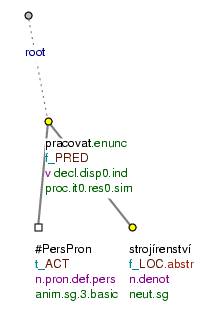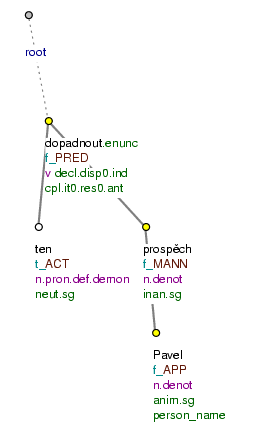Many secondary prepositions are represented as prepositions in tectogrammatical trees.
Expressions represented as secondary prepositions are introduced in Appendix C, Secondary prepositions. However, an expression included in this list is not always a secondary preposition. Words listed as components of a secondary preposition can have their own semantic and syntactic significance in the clause, in which case they are represented by a separate node in the tree and do not form a component of the preposition. Cf.:
-
Pracuje <v oboru> strojírenství. (=He/She works in the field of mechanical engineering.)
= Pracuje ve strojírenství. (=He/She works in mechanical engineering.)
The expression v oboru (=in the field) is a secondary preposition in the sentence. Cf. Fig. 8.288.
-
Studuje <v> oboru matematická lingvistika.
= Studuje obor matematická lingvistika. (=His/Her field of study is mathematical linguistics.)
The expression v oboru (=in the field) is not a secondary preposition. The word obor (=field) has semantic and syntactic significance in the sentence. Only the primary preposition v (=in) is a preposition.
The potential secondary preposition is not a secondary preposition if any of its components is further modified. Cf.:
-
<Na> nejednoznačném základě smlouvy byla dohodnuta další ujednání. (=On the equivocal basis of the agreement, further negotiations were agreed on.)
The expression na základě (=on the basis) is not a secondary preposition in the sentence.
-
Krok byl podniknut <v> jistém zájmu této firmy. (=The step was taken in the clear interest of this company.)
The expression v zájmu (=in the interest) is not a secondary preposition in the sentence.
-
<Z> určitého hlediska se to dá tak chápat. (=From a particular point of view it can be understood as such.)
The expression z hlediska (=from the point of view) is not a secondary preposition in the sentence.
!!! There are three cases when a component of a potential secondary preposition is modified which stand out as candidates for representation in future as secondary prepositions but which are currently not so represented:
-
modification of a prepositional phrase by a possessive pronoun or adjective.
Cf.:
-
ve prospěch Pavla (=to Paul's advantage)
In this case the expression ve prospěch (=to the advantage) is represented in PDT as a secondary preposition. Cf. Fig. 8.289.
-
v Pavlův prospěch (=to Paul's advantage)
In this case the expression ve prospěch (=to the advantage) is not currently represented in PDT as a secondary preposition. Cf. Fig. 8.290.
-
v jeho prospěch (=to his advantage)
In this case the expression ve prospěch (=to the advantage) is not currently represented in PDT as a secondary preposition.
-
-
modification of a prepositional phrase by a (non-possessive) adjective derived from a noun incapable of forming a possessive adjective.
Cf.:
-
ve prospěch firmy (=to the company's advantage)
In this case the expression ve prospěch (=to the advantage) is represented in PDT as a secondary preposition.
-
ve firemní prospěch (=to the company's advantage)
In this case the expression ve prospěch (=to the advantage) is currently not represented in PDT as a secondary preposition.
-
v její prospěch (=to its advantage)
In this case the expression ve prospěch (=to the advantage) is not currently represented in PDT as a secondary preposition.
-
-
modification of a prepositional phrase by the demonstrative pronoun ten (=that):
Cf.:
-
na základě všech řešení (=on the basis of all the solutions)
In this case the expression na základě (=on the basis) is represented in PDT as a secondary preposition.
-
na tomto základě (=on that basis)
In this case the expression na základě (=on the basis) is not currently represented in PDT as a secondary preposition.
-
Figure 8.288. Secondary preposition

Pracuje v oboru strojírenství. (=lit. (He/She) works in (the) field (of) mechanical_engineering.)

